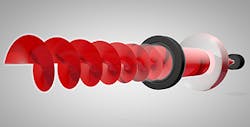Piezoelectrically driven acousto-optics enable ultrafast steering and shaping of light beams
Researchers from the University of Bristol (Bristol, England) and the University of Dundee (Dundee, Scotland) have created an acousto-optic device that can turn a Gaussian laser beam into a Bessel beam with selectable order.1 Bessel beams that have spiral phase fronts (with higher orders having a higher orbital angular momentum) can be used for micromanipulation and even as tractor beams.
The phased-array device contains 64 piezoelectric elements surrounding a liquid-filled cavity. Bessel beams up to the fourth order can be produced by the array; the beams can also be steered. The refresh rate of 1 MHz ensures high beam-steering and alteration rates. The technology can enable optical devices such as holographs that can move rapidly in real time.
The research was led by Bruce Drinkwater, Professor of Ultrasonics at the University of Bristol and Mike MacDonald at the University of Dundee.
Professor Drinkwater from the Department of Mechanical Engineering said: "This reconfigurability can happen extremely fast, limited only by the speed of the sound waves," says Drinkwater. "The key advantage of this method is that it potentially offers very high refresh rates—millions of refreshes per second is now possible. This means that in the future laser-beam-based devices will be able to be reconfigured much faster than is currently possible. Previously, the fastest achieved is a few thousand refreshes per second."
Reconfigurable lenses
"The device can potentially be addressed much more quickly than existing holographic devices, such as spatial light modulators, and will also allow for much higher laser powers to be used," says MacDonald. "This opens up applications such as beam shaping in laser processing of materials, or even fast and high power control of light beams for free space optical communications using orbital angular momentum to increase signal bandwidth, as shown recently by a demonstration in Vienna."
The approach is not limited to the production of Bessel beams; in principle, arbitrary phase distributions can be created by the device.
Source: http://www.bris.ac.uk/news/2015/january/acousto-optic-device-.html
REFERENCE:
1. A. Grinenko et al., Optics Express (2015); http://dx.doi.org/10.1364/OE.23.000026

John Wallace | Senior Technical Editor (1998-2022)
John Wallace was with Laser Focus World for nearly 25 years, retiring in late June 2022. He obtained a bachelor's degree in mechanical engineering and physics at Rutgers University and a master's in optical engineering at the University of Rochester. Before becoming an editor, John worked as an engineer at RCA, Exxon, Eastman Kodak, and GCA Corporation.
